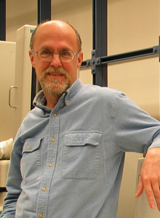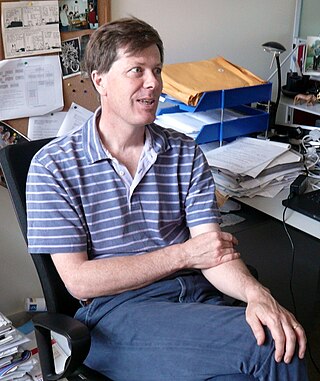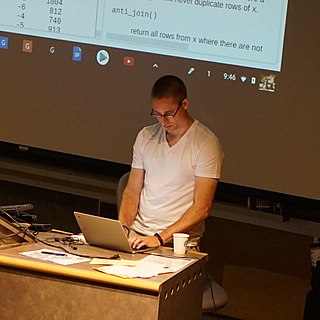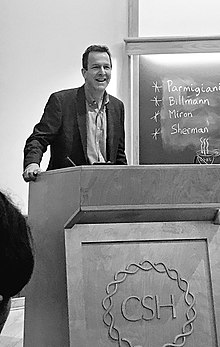
Bioinformatics is an interdisciplinary field of science that develops methods and software tools for understanding biological data, especially when the data sets are large and complex. Bioinformatics uses biology, chemistry, physics, computer science, computer programming, information engineering, mathematics and statistics to analyze and interpret biological data. The subsequent process of analyzing and interpreting data is referred to as computational biology.

Comparative genomics is a field of biological research in which the genomic features of different organisms are compared. The genomic features may include the DNA sequence, genes, gene order, regulatory sequences, and other genomic structural landmarks. In this branch of genomics, whole or large parts of genomes resulting from genome projects are compared to study basic biological similarities and differences as well as evolutionary relationships between organisms. The major principle of comparative genomics is that common features of two organisms will often be encoded within the DNA that is evolutionarily conserved between them. Therefore, comparative genomic approaches start with making some form of alignment of genome sequences and looking for orthologous sequences in the aligned genomes and checking to what extent those sequences are conserved. Based on these, genome and molecular evolution are inferred and this may in turn be put in the context of, for example, phenotypic evolution or population genetics.

Michael Ashburner was an English biologist and Professor in the Department of Genetics at University of Cambridge. He was also the former joint-head and co-founder of the European Bioinformatics Institute (EBI) of the European Molecular Biology Laboratory (EMBL) and a Fellow of Churchill College, Cambridge.
In bioinformatics, GLIMMER (Gene Locator and Interpolated Markov ModelER) is used to find genes in prokaryotic DNA. "It is effective at finding genes in bacteria, archea, viruses, typically finding 98-99% of all relatively long protein coding genes". GLIMMER was the first system that used the interpolated Markov model to identify coding regions. The GLIMMER software is open source and is maintained by Steven Salzberg, Art Delcher, and their colleagues at the Center for Computational Biology at Johns Hopkins University. The original GLIMMER algorithms and software were designed by Art Delcher, Simon Kasif and Steven Salzberg and applied to bacterial genome annotation in collaboration with Owen White.

Webb Colby Miller is an American bioinformatician who is professor in the Department of Biology and the Department of Computer Science and Engineering at The Pennsylvania State University.
MUMmer is a bioinformatics software system for sequence alignment. It is based on the suffix tree data structure. It has been used for comparing different genomes assemblies to one another, which allows scientists to determine how a genome has changed. The acronym "MUMmer" comes from "Maximal Unique Matches", or MUMs.

RNA-Seq is a technique that uses next-generation sequencing (NGS) to reveal the presence and quantity of RNA molecules in a biological sample, providing a snapshot of gene expression in the sample, also known as transcriptome.

Richard Michael Durbin is a British computational biologist and Al-Kindi Professor of Genetics at the University of Cambridge. He also serves as an associate faculty member at the Wellcome Sanger Institute where he was previously a senior group leader.

Lincoln David Stein is a scientist and Professor in bioinformatics and computational biology at the Ontario Institute for Cancer Research.
Bowtie is a software package commonly used for sequence alignment and sequence analysis in bioinformatics. The source code for the package is distributed freely and compiled binaries are available for Linux, macOS and Windows platforms. As of 2017, the Genome Biology paper describing the original Bowtie method has been cited more than 11,000 times. Bowtie is open-source software and is currently maintained by Johns Hopkins University.
Mathieu Daniel Blanchette is a computational biologist and Director of the School of Computer Science at McGill University. His research focuses on developing new algorithms for the detection of functional regions in DNA sequences.

Bonnie Anne Berger is an American mathematician and computer scientist, who works as the Simons professor of mathematics and professor of electrical engineering and computer science at the Massachusetts Institute of Technology. Her research interests are in algorithms, bioinformatics and computational molecular biology.

Lior Samuel Pachter is a computational biologist. He works at the California Institute of Technology, where he is the Bren Professor of Computational Biology. He has widely varied research interests including genomics, combinatorics, computational geometry, machine learning, scientific computing, and statistics.
TopHat is an open-source bioinformatics tool for the throughput alignment of shotgun cDNA sequencing reads generated by transcriptomics technologies using Bowtie first and then mapping to a reference genome to discover RNA splice sites de novo. TopHat aligns RNA-Seq reads to mammalian-sized genomes.
Ben Langmead is a computational biologist and associate professor in the Computational Biology & Medicine Group at Johns Hopkins University.
Owen R. White is a bioinformatician and director of the Institute For Genome Sciences at the University of Maryland School of Medicine, United States. He is known for his work on the bioinformatics tools GLIMMER and MUMmer.

Jeffrey Tullis Leek is an American biostatistician and data scientist working as a Vice President, Chief Data Officer, and Professor at Fred Hutchinson Cancer Research Center. He is an author of the Simply Statistics blog, and runs several online courses through Coursera, as part of their Data Science Specialization. His most popular course is The Data Scientist's Toolbox, which he instructed along with Roger Peng and Brian Caffo. Leek is best known for his contributions to genomic data analysis and critical view of research and the accuracy of popular statistical methods.

Bruce Colston Trapnell Jr. is an assistant professor in the Department of Genome Sciences at the University of Washington. He was awarded the Overton Prize by the International Society for Computational Biology (ISCB) for “outstanding accomplishment in the early to mid stage of his career” in 2018.











